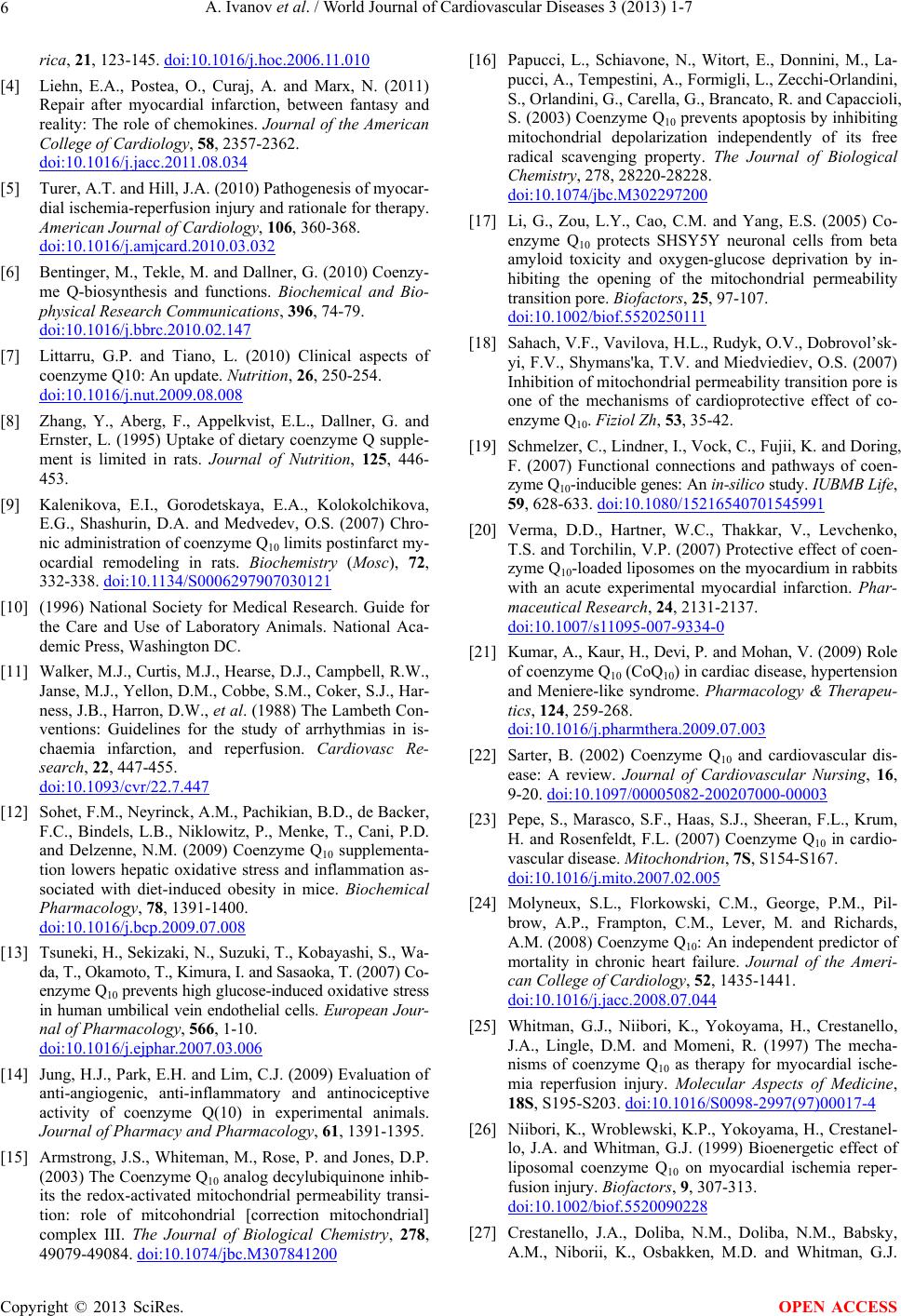
A. Ivanov et al. / World Journal of Cardiovascular Diseases 3 (2013) 1-7
6
rica, 21, 123-145. doi:10.1016/j.hoc.2006.11.010
[4] Liehn, E.A., Postea, O., Curaj, A. and Marx, N. (2011)
Repair after myocardial infarction, between fantasy and
reality: The role of chemokines. Journal of the American
College of Cardiology, 58, 2357-2362.
doi:10.1016/j.jacc.2011.08.034
[5] Turer, A.T. and Hill, J.A. (2010) Pathogenesis of myocar-
dial ischemia-reperfusion injury and rationale for therapy.
American Journal of Cardiology, 106, 360-368.
doi:10.1016/j.amjcard.2010.03.032
[6] Bentinger, M., Tekle, M. and Dallner, G. (2010) Coenzy-
me Q-biosynthesis and functions. Biochemical and Bio-
physical Research Communications, 396, 74-79.
doi:10.1016/j.bbrc.2010.02.147
[7] Littarru, G.P. and Tiano, L. (2010) Clinical aspects of
coenzyme Q10: An update. Nutrition, 26, 250-254.
doi:10.1016/j.nut.2009.08.008
[8] Zhang, Y., Aberg, F., Appelkvist, E.L., Dallner, G. and
Ernster, L. (1995) Uptake of dietary coenzyme Q supple-
ment is limited in rats. Journal of Nutrition, 125, 446-
453.
[9] Kalenikova, E.I., Gorodetskaya, E.A., Kolokolchikova,
E.G., Shashurin, D.A. and Medvedev, O.S. (2007) Chro-
nic administration of coenzyme Q10 limits postinfarct my-
ocardial remodeling in rats. Biochemistry (Mosc), 72,
332-338. doi:10.1134/S0006297907030121
[10] (1996) National Society for Medical Research. Guide for
the Care and Use of Laboratory Animals. National Aca-
demic Press, Washington DC.
[11] Walker, M.J., Curtis, M.J., Hearse, D.J., Campbell, R.W.,
Janse, M.J., Yellon, D.M., Cobbe, S.M., Coker, S.J., Har-
ness, J.B., Harron, D.W., et al. (1988) The Lambeth Con-
ventions: Guidelines for the study of arrhythmias in is-
chaemia infarction, and reperfusion. Cardiovasc Re-
search, 22, 447-455.
doi:10.1093/cvr/22.7.447
[12] Sohet, F.M., Neyrinck, A.M., Pachikian, B.D., de Backer,
F.C., Bindels, L.B., Niklowitz, P., Menke, T., Cani, P.D.
and Delzenne, N.M. (2009) Coenzyme Q10 supplementa-
tion lowers hepatic oxidative stress and inflammation as-
sociated with diet-induced obesity in mice. Biochemical
Pharmacology, 78, 1391-1400.
doi:10.1016/j.bcp.2009.07.008
[13] Tsuneki, H., Sekizaki, N., Suzuki, T., Kobayashi, S., Wa-
da, T., Okamoto, T., Kimura, I. and Sasaoka, T. (2007) Co-
enzyme Q10 prevents high glucose-induced oxidative stress
in human umbilical vein endothelial cells. European Jour-
nal of Pharmacology, 566, 1-10.
doi:10.1016/j.ejphar.2007.03.006
[14] Jung, H.J., Park, E.H. and Lim, C.J. (2009) Evaluation of
anti-angiogenic, anti-inflammatory and antinociceptive
activity of coenzyme Q(10) in experimental animals.
Journal of Pharmacy and Pharmacology, 61, 1391-1395.
[15] Armstrong, J.S., Whiteman, M., Rose, P. and Jones, D.P.
(2003) The Coenzyme Q10 analog decylubiquinone inhib-
its the redox-activated mitochondrial permeability transi-
tion: role of mitcohondrial [correction mitochondrial]
complex III. The Journal of Biological Chemistry, 278,
49079-49084. doi:10.1074/jbc.M307841200
[16] Papucci, L., Schiavone, N., Witort, E., Donnini, M., La-
pucci, A., Tempestini, A., Formigli, L., Zecchi-Orlandini,
S., Orlandini, G., Carella, G., Brancato, R. and Capaccioli,
S. (2003) Coenzyme Q10 prevents apoptosis by inhibiting
mitochondrial depolarization independently of its free
radical scavenging property. The Journal of Biological
Chemistry, 278, 28220-28228.
doi:10.1074/jbc.M302297200
[17] Li, G., Zou, L.Y., Cao, C.M. and Yang, E.S. (2005) Co-
enzyme Q10 protects SHSY5Y neuronal cells from beta
amyloid toxicity and oxygen-glucose deprivation by in-
hibiting the opening of the mitochondrial permeability
transition pore. Biofactors, 25, 97-107.
doi:10.1002/biof.5520250111
[18] Sahach, V.F., Vavilova, H.L., Rudyk, O.V., Dobrovol’sk-
yi, F.V., Shymans'ka, T.V. and Miedviediev, O.S. (2007)
Inhibition of mitochondrial permeability transition pore is
one of the mechanisms of cardioprotective effect of co-
enzyme Q10. Fiziol Zh, 53, 35-42.
[19] Schmelzer, C., Lindner, I., Vock, C., Fujii, K. and Doring,
F. (2007) Functional connections and pathways of coen-
zyme Q10 -inducible genes: An in-silico study. IUBMB Life,
59, 628-633. doi:10.1080/15216540701545991
[20] Verma, D.D., Hartner, W.C., Thakkar, V., Levchenko,
T.S. and Torchilin, V.P. (2007) Protective effect of coen-
zyme Q10-loaded liposomes on the myocardium in rabbits
with an acute experimental myocardial infarction. Phar-
maceutical Research, 24, 2131-2137.
doi:10.1007/s11095-007-9334-0
[21] Kumar, A., Kaur, H., Devi, P. and Mohan, V. (2009) Role
of coenzyme Q10 (CoQ10) in cardiac disease, hypertension
and Meniere-like syndrome. Pharmacology & Therapeu-
tics, 124, 259-268.
doi:10.1016/j.pharmthera.2009.07.003
[22] Sarter, B. (2002) Coenzyme Q10 and cardiovascular dis-
ease: A review. Journal of Cardiovascular Nursing, 16,
9-20. doi:10.1097/00005082-200207000-00003
[23] Pepe, S., Marasco, S.F., Haas, S.J., Sheeran, F.L., Krum,
H. and Rosenfeldt, F.L. (2007) Coenzyme Q10 in cardio-
vascular disease. Mitochondrion, 7S, S154-S167.
doi:10.1016/j.mito.2007.02.005
[24] Molyneux, S.L., Florkowski, C.M., George, P.M., Pil-
brow, A.P., Frampton, C.M., Lever, M. and Richards,
A.M. (2008) Coenzyme Q10: An independent predictor of
mortality in chronic heart failure. Journal of the Ameri-
can College of Cardiology, 52, 1435-1441.
doi:10.1016/j.jacc.2008.07.044
[25] Whitman, G.J., Niibori, K., Yokoyama, H., Crestanello,
J.A., Lingle, D.M. and Momeni, R. (1997) The mecha-
nisms of coenzyme Q10 as therapy for myocardial ische-
mia reperfusion injury. Molecular Aspects of Medicine,
18S, S195-S203. doi:10.1016/S0098-2997(97)00017-4
[26] Niibori, K., Wroblewski, K.P., Yokoyama, H., Crestanel-
lo, J.A. and Whitman, G.J. (1999) Bioenergetic effect of
liposomal coenzyme Q10 on myocardial ischemia reper-
fusion injury. Biofactors, 9, 307-313.
doi:10.1002/biof.5520090228
[27] Crestanello, J.A., Doliba, N.M., Doliba, N.M., Babsky,
A.M., Niborii, K., Osbakken, M.D. and Whitman, G.J.
Copyright © 2013 SciRes. OPEN ACCESS